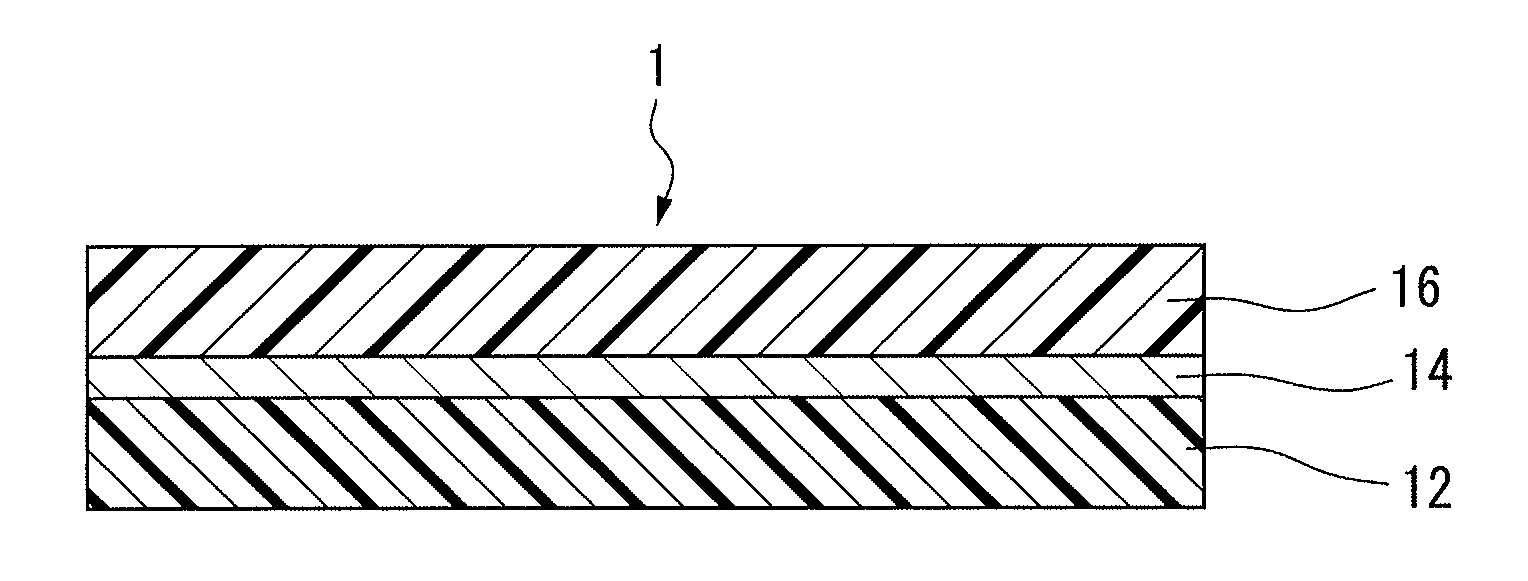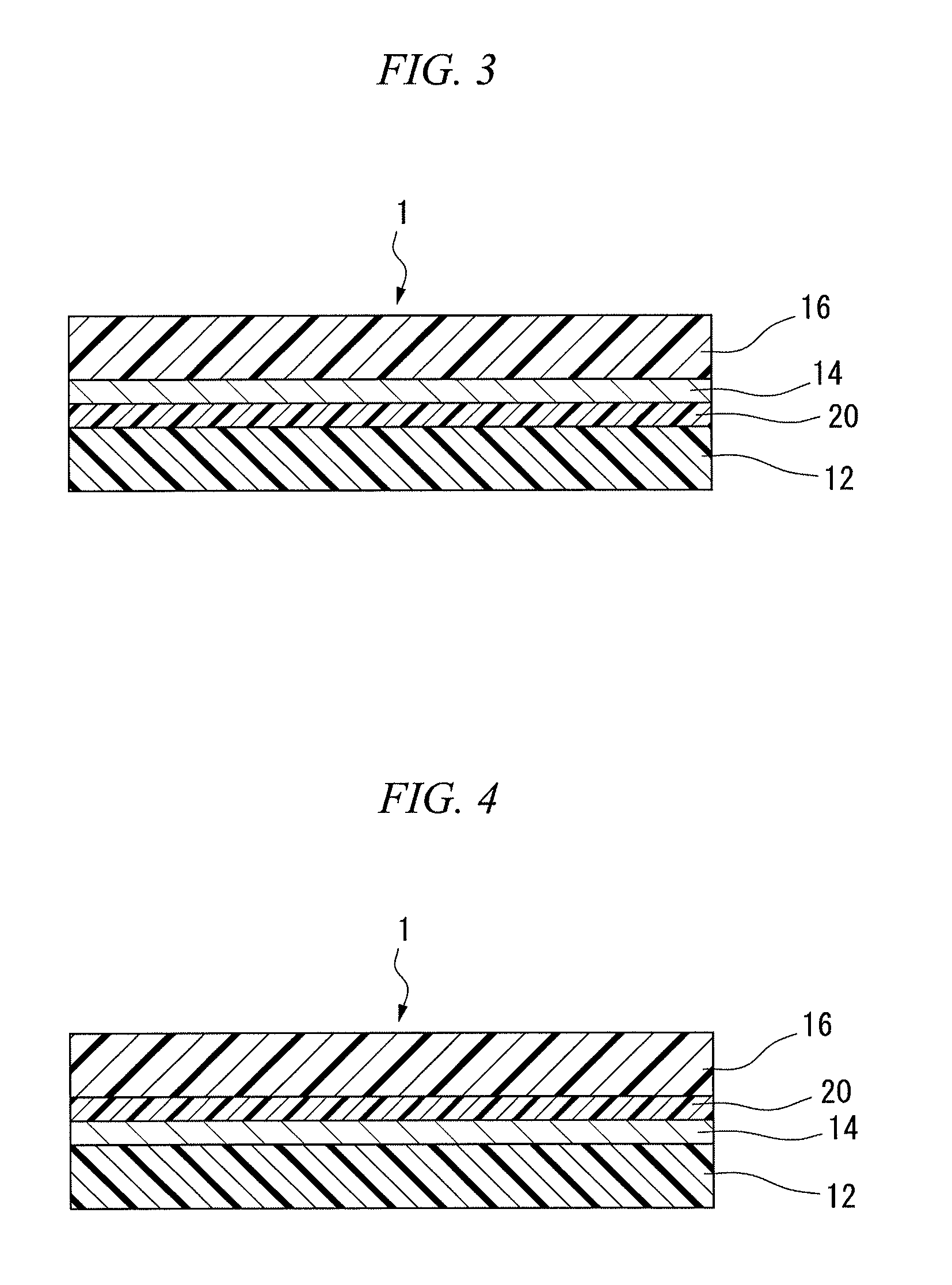Radio wave-transmitting decorative film and decorative member using same
a technology of decorative film and metallic gloss, which is applied in the field of radio wave-transmitting decorative film having metallic gloss and a decorative member using the same, can solve the problems of low productivity, tin is prone to oxidation, and low productivity, and achieves excellent stretch moldability, low cost, and not easily disappearing
- Summary
- Abstract
- Description
- Claims
- Application Information
AI Technical Summary
Benefits of technology
Problems solved by technology
Method used
Image
Examples
example 1
[0187]The surface of acryl film, as a first polymer film 12, having a thickness of 50 μm, was subjected to physical vapor deposition using a DC sputtering apparatus with the following target to form a light-reflecting layer 14.
[0188]An alloy composed of silicon and aluminum which was doped with boron (aluminum proportion: 60 volume %, amount of doped boron: approximately 10−7 mol %) was used as the target. The reflectance of the elemental form of aluminum is 87.6%.
[0189]Then, acryl film, as a second polymer film 16, having a thickness of 50 μm, was subjected to thermal lamination on the surface of the light-reflecting layer 14 to obtain a decorative film 1 shown in FIG. 1.
[0190]With respect to the obtained decorative film 1, the thickness of the light-reflecting layer 14, the amounts of transmission attenuation (S21) at 1 GHz and 3 GHz, the reflectance of visible light entered from first polymer film 12, the surface resistivity, and the average surface roughness were measured. In ad...
example 2
[0193]The surface of polycarbonate film having a thickness of 100 μm as a first polymer film 12 was subjected to physical vapor deposition at a flow of nitrogen gas of 0.5 sccm, to form a light-reflecting layer 14 of which a portion was formed into ceramics, using a DC sputtering apparatus with the same target as Example 1.
[0194]Then, a polyolefin chloride layer was laminated on the surface of black ABS film having a thickness of 100 μm as a second polymer film 16 and the polyolefin chloride layer was used as an adhesive, which was adhered to light-reflecting layer 14 to obtain a decorative film 1.
[0195]With respect to the obtained decorative film 1, the thickness of the light-reflecting layer 14, the amounts of transmission attenuation (S21) at 1 GHz and 3 GHz, the reflectance, the surface resistivity, and the average surface roughness were measured. In addition, the external appearance of the decorative film 1 was observed. The results are shown in Table 1.
[0196]The decorative fil...
example 3
[0197]A laminate of a copolymerizable polyester film (manufactured by Toyobo Co., Ltd., trade name Softshine) having a thickness of 25 μm and an acryl film having a thickness of 50 μm was prepared as a first polymer film 12.
[0198]On the surface of the copolymerizable polyester film, oxygen plasma processing was performed under conditions of power: 500 W, time: 2 minutes, reaching vacuum degree: 6×10−1 Pa, oxygen flow rate: 15 sccm.
[0199]On the surface treated with plasma, physical vapor deposition was performed using an alloy (aluminum proportion: 70 volume %) of silicon and aluminum by a DC sputtering apparatus as a target, to form a light-reflecting layer 14.
[0200]Black ABS film was adhered in a manner similar to Example 2, to obtain a decorative film 1.
[0201]With respect to the obtained decorative film 1, the thickness of the light-reflecting layer 14, the amounts of transmission attenuation (S21) at 1 GHz and 3 GHz, the reflectance, the surface resistivity, and the average surfa...
PUM
| Property | Measurement | Unit |
|---|---|---|
| thickness | aaaaa | aaaaa |
| thickness | aaaaa | aaaaa |
| surface roughness | aaaaa | aaaaa |
Abstract
Description
Claims
Application Information
 Login to View More
Login to View More - R&D
- Intellectual Property
- Life Sciences
- Materials
- Tech Scout
- Unparalleled Data Quality
- Higher Quality Content
- 60% Fewer Hallucinations
Browse by: Latest US Patents, China's latest patents, Technical Efficacy Thesaurus, Application Domain, Technology Topic, Popular Technical Reports.
© 2025 PatSnap. All rights reserved.Legal|Privacy policy|Modern Slavery Act Transparency Statement|Sitemap|About US| Contact US: help@patsnap.com



